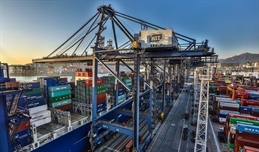
Seaborne reefer trade is poised for a return to growth in 2023, with volumes set to increase by 2.1%, outpacing the wider dry cargo trade, to reach 140.5 million tonnes this year, according to a new analysis by independent maritime research consultancy firm, Drewry.
In its latest projections published in Drewry's Reefer Shipping Forecaster, it noted that looking further ahead, reefer shipping will continue to outgun other cargo types as the perishables trade proves more resilient to economic downturns.
"Having weathered numerous storms in 2022 when the trade stagnated, the outlook for the reefer sector is now looking much more favourable, as easing supply chain disruption and growing cargo demand help to support volume growth," the report said.
The latest Drewry trade estimates also show that all reefer intensive trade routes experienced year-on-year growth in the first quarter of 2023, for first time since Drewry started analysing the trade in 2016, with total seaborne reefer trade expanding 2.7%.
Increased demand from Asia
Drewry said increased demand from Asia emerged as a key driver in the first quarter, with the reopening of the Chinese economy fuelling demand for seaborne reefer trade.
Among the largest-volume commodities, meat and fish shipments have shown promising growth so far this year, with the former expected to recover from last year's contraction with growth of 2.4% in 2023 and the fish trade not far behind. But banana shipments still remain underpowered due to increasing cost pressures, it added.
"The recovery in the meat trade is expected to power growth on both North America-Asia and North Europe-Asia trade routes, with the former forecast to deliver the highest annualised growth of 4.6% over the next 5 years," the maritime research consultancy firm said.
Meanwhile, it added that the re-opening of China's economy continues to add positive momentum to the growth outlook in 2023 — "but sentiment still remains somewhat cautious as persistent threats of recession, high inflation and the anticipated arrival of El Niño this year, which is already starting to disrupt fruit production in the Pacific and Americas, will add significant downside risks."
In the short term, it said that improvements to supply chains are expected to continue as the cost of repositioning empty reefer containers eases, resulting in a boost to supply.
"The reefer container equipment fleet is also poised to expand, following a decline in reefer box manufacturing in recent quarters, with average annual growth of 3.7% forecast over the next four years," Drewry added.
The analysis also said that container availability has been a significant hurdle in recent times, helping to lift Drewry's Reefer Container Freight Rate Index to record highs last year. But with repositioning costs receding, freight rates have fallen sharply in the second quarter of 2023, declining 17% year-on-year according to Drewry's latest estimates.
"But the decline in reefer rates has been much less pronounced than that for dry containers, and Drewry forecasts that the former will continue to outperform the latter," Drewry further said.
"Underpinning this projection is the buoyant outlook for the reefer shipping trade, with global cargo demand expected to expand at an average annual rate of 3.3% over the next 5 years, broadly in line with pre-pandemic trend. Meanwhile, container carriers will see their carryings rise at an even higher rate of 4% a year, as specialised reefer vessel share of the trade continues to decline," the report added.



